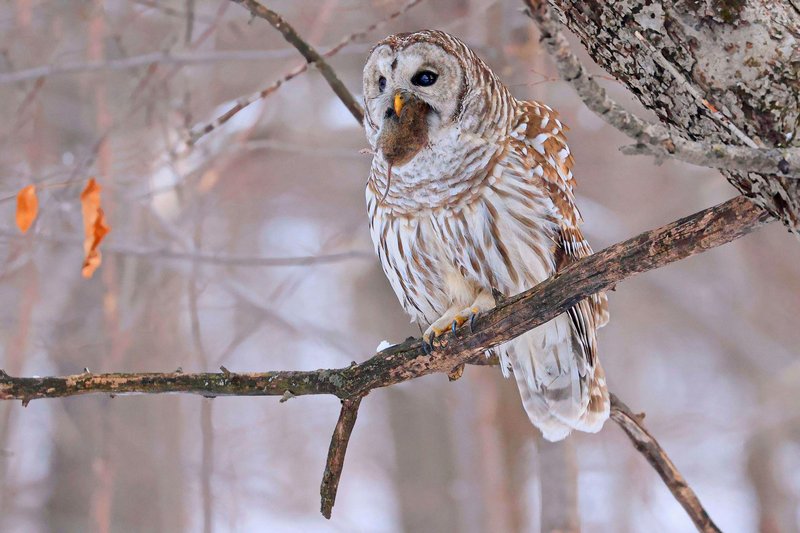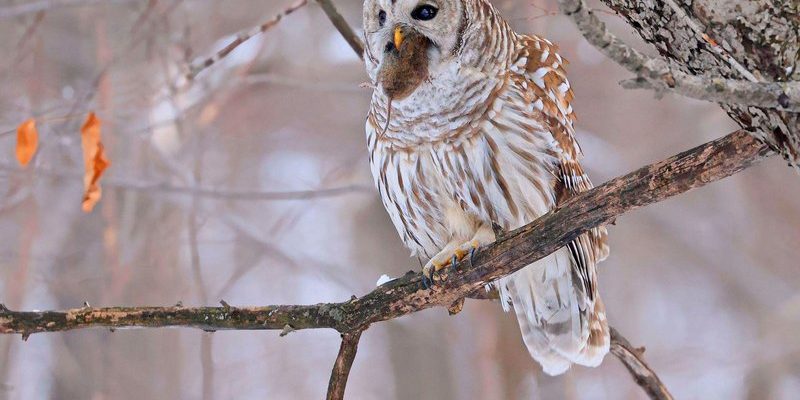
Barred owls are masters of adaptation, which means their eating habits can vary based on where they live. These owls have a diverse menu, and knowing what they eat can give you insights into their role in the ecosystem. So, let’s explore what a barred owl eats and how it finds its meals.
Understanding the Diet of the Barred Owl
Barred owls have a varied diet that largely consists of small mammals, birds, and even insects. Think of them as the ultimate scavengers of the night. Their main course typically includes:
- Rodents: Mice and voles are favorites.
- Birds: They often snack on smaller birds like sparrows and jays.
- Insects: In warmer months, crickets and grasshoppers can be a part of their diet.
They are not picky eaters, which is a good trait in a predator. Depending on availability, they can also catch rabbits, squirrels, and even the occasional snake. This flexibility helps barred owls thrive in various habitats, from dense forests to urban areas.
You might wonder why they choose such a wide array of food. Well, it’s all about adaptation. When certain prey is abundant, they’ll feast on it. But if that food source dwindles, they can switch gears and target different prey. This versatility ensures that barred owls can survive in different environments.
The Hunting Techniques of Barred Owls
Hunting for barred owls is an art form. They’re expert hunters, utilizing their keen senses of sight and hearing. Imagine walking through a dark forest—you might feel a bit lost, but not these owls. Their large eyes are designed for low-light conditions, giving them incredible night vision.
When they’re on the hunt, barred owls enter stealth mode. They perch silently on branches, scanning the ground for movement. They can detect the slightest rustle, thanks to their excellent hearing. Once they spot a potential meal, they swoop down with remarkable speed and precision. Here’s a fun fact: they can catch prey as large as 1.5 times their own weight!
They often hunt alone or in pairs, which allows them to cover more ground. But even when they’re alone, they can be incredibly successful. If you’ve ever heard one of their distinctive calls echoing through the woods at night, you know there’s a skilled hunter out there, waiting for the right moment to strike.
How Barred Owls Forage in Different Environments
Foraging is another important part of a barred owl’s feeding strategy. While hunting involves quick strikes, foraging is about exploration and patience. Barred owls will often hunt in various locations, depending on what they can find.
In dense forests, they tend to rely on their stealth. The thick branches provide cover, allowing them to sneak up on unsuspecting prey. They’ll also explore the forest floor for any snacks, like insects or small mammals hiding among the leaves.
In more open areas, like marshes and fields, barred owls may adjust their strategy. Instead of waiting in trees, they might land on the ground or low shrubs to catch prey. This adaptability ensures they can find food no matter the landscape.
You might be surprised to learn that these owls have been known to hunt during the daytime. Although mostly nocturnal, they can forage in daylight if the opportunity arises. This behavior is especially common when food is scarce or when they’re feeding young chicks.
Seasonal Changes in Diet
As seasons change, so does the barred owl’s menu. In winter, their diet mainly consists of small mammals, as these critters are more readily available beneath the snow. They can easily hear the subtle movements of mice and voles tunneling underneath.
In spring and summer, you’ll notice a shift. Baby birds make a tasty treat, and young animals are plentiful. During these months, barred owls may increase their hunting of smaller birds, taking advantage of the abundance.
The seasonal variation also affects foraging behavior. In colder months, they might stick to their favorite hunting grounds where prey is consistent. As temperatures rise, they’ll explore new areas, seeking out different food sources. It’s a constant game of survival, and barred owls adapt as needed.
The Role of Barred Owls in Their Ecosystem
Barred owls play a significant role in their ecosystem. As predators, they help control rodent populations, which can impact local vegetation and other wildlife. Think of them as nature’s pest control agents.
By keeping these populations in check, they help maintain a balance in their habitats. A thriving rodent population could lead to overgrazing of plants, affecting other species that rely on those plants for survival.
Moreover, barred owls are also prey to larger birds of prey and other predators. This includes animals like the great horned owl and some larger mammals. Their position in the food chain highlights the interconnectedness of wildlife and the importance of each species.
Conservation Status and Threats
While barred owls are currently not considered endangered, they face various threats. Habitat loss, primarily due to urban development and deforestation, is a major concern. As their natural habitats shrink, finding food and nesting sites becomes more difficult.
Competition with other species, such as the invasive spotted owl, is another challenge. Barred owls have adapted well and often outcompete native birds for resources, which can further threaten local ecosystems.
Conservation efforts are crucial to ensure these magnificent birds remain a part of our natural landscape. Protecting their habitats and promoting awareness about their importance can help secure their future.
Barred owls are fascinating creatures with a rich diet and versatile hunting techniques. Their ability to adapt to different environments and food sources is part of what makes them so successful. By understanding what the barred owl eats and how it hunts, we gain insight into their role in our ecosystems and the importance of preserving their habitats. So, next time you hear that iconic call in the night, you’ll have a deeper appreciation for what this amazing bird represents—nature’s skilled hunter and an essential part of our wildlife community.

